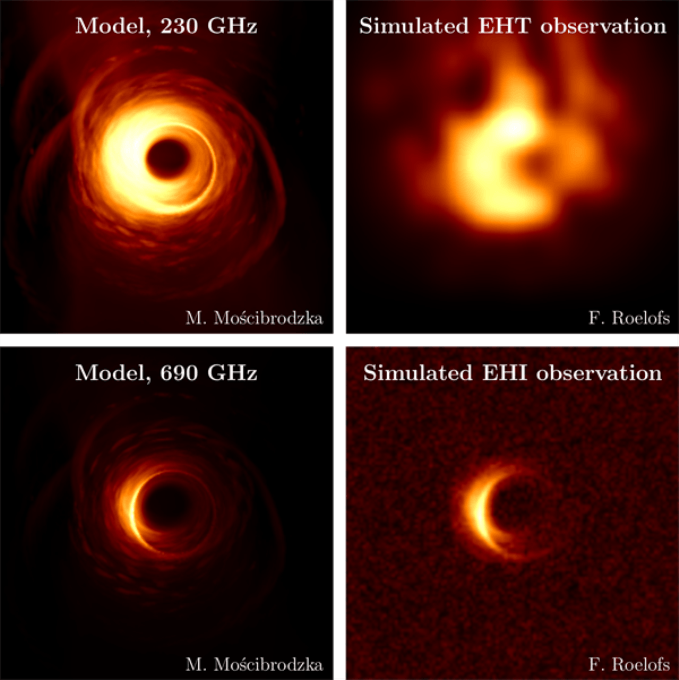May 7 2019
More recently, astronomers managed to capture the first-ever image of a black hole, and the next challenge that they now face is to capture even sharper images to enable Einstein’s Theory of General Relativity to be tested.
 In space, the EHI has a resolution more than five times that of the EHT on earth, and images can be reconstructed with higher fidelity. Top left: Model of Sagittarius A* at an observation frequency of 230 GHz. Top left: Simulation of an image of this model with the EHT. Bottom left: Model of Sagittarius A* at an observation frequency of 690 GHz. Bottom right: Simulation of an image of this model with the EHI. (Image credit: F. Roelofs and M. Moscibrodzka, Radboud University)
In space, the EHI has a resolution more than five times that of the EHT on earth, and images can be reconstructed with higher fidelity. Top left: Model of Sagittarius A* at an observation frequency of 230 GHz. Top left: Simulation of an image of this model with the EHT. Bottom left: Model of Sagittarius A* at an observation frequency of 690 GHz. Bottom right: Simulation of an image of this model with the EHI. (Image credit: F. Roelofs and M. Moscibrodzka, Radboud University)
Astronomers from Radboud University collaborated with the European Space Agency (ESA) and others to come up with a concept for realizing this by launching radio telescopes into space. They have reported their plans in the scientific journal Astronomy & Astrophysics.
The concept, named Event Horizon Imager (EHI), is to position two or three satellites around the Earth in a circular orbit to observe black holes. In the new research, the researchers have presented simulations of how images of the black hole Sagittarius A* would look like if they were captured by satellites such as these.
More than Five Times as Sharp
There are lots of advantages to using satellites instead of permanent radio telescopes on Earth, as with the Event Horizon Telescope (EHT). In space, you can make observations at higher radio frequencies, because from Earth these are filtered out by the atmosphere. The distances between the telescopes in space are also larger. This allows us to take a big step forward. We would be able to take images with a resolution more than five times what is possible with the EHT.
Freek Roelofs, Study Lead Author and PhD Candidate, Radboud University
Sharper images of a black hole will result in better information that could be employed to test Einstein’s Theory of General Relativity in much higher detail.
The fact that the satellites are moving round the Earth makes for considerable advantages. With them, you can take near perfect images to see the real details of black holes. If small deviations from Einstein’s theory occur, we should be able to see them.
Heino Falcke, Radio Astronomy Professor, Radboud University
The EHI will also be in a position to image nearly five additional black holes smaller than the black holes that are currently being focused by the EHT. The latter are M87* located at the center of Messier 87, a huge galaxy in the Virgo Cluster, and Sagittarius A* located at the center of the Milky Way galaxy.
Technological Challenges
The scientists have simulated what could possibly be observed using different versions of the technology under various circumstances. To achieve this, they used models of plasma behavior around the black hole and the ensuing radiation.
The simulations look promising from a scientific aspect, but there are difficulties to overcome at a technical level.
Freek Roelofs, Study Lead Author and PhD Candidate, Radboud University
The astronomers worked with researchers from ESA/ESTEC to test for the technical possibility of the project. “The concept demands that you must be able to ascertain the position and speed of the satellites very accurately,” stated Volodymyr Kudriashov, a researcher at the Radboud Radio Lab who also works at ESA/ESTEC. “But we really believe that the project is feasible.”
The way the satellites exchange data is also taken into account. “With the EHT, hard drives with data are transported to the processing centre by airplane. That’s of course not possible in space.” In this concept, the satellites will use a laser link to exchange data, where the data will be processed partially on board before it is sent back to Earth for further analysis. “There are already laser links in space,” noted Kudriashov.
Hybrid System
The concept is that the satellites will first act independently of the EHT telescopes. However, a hybrid system is also being considered, where the orbiting telescopes will be combined with the ones on Earth.
Using a hybrid like this could provide the possibility of creating moving images of a black hole, and you might be able to observe even more and also weaker sources.
Heino Falcke, Radio Astronomy Professor, Radboud University